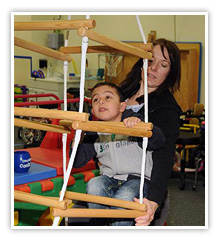
 Pediatric Physical Therapy
Pediatric Physical Therapy
Nassau County & Suffolk County - Long Island
 What is Pediatric Physical Therapy?
What is Pediatric Physical Therapy?
Physical Therapy as part of a child’s Early Intervention Individualized Family Service Plan (IFSP) or Individualized Education Program (IEP) in a Preschool Special Education setting, are therapeutic interventions aimed at maximizing a child’s ability to participate in daily activities in school and at home. The goal specific outcomes of Physical Therapy promote independence and age-appropriate gross motor development, improve strength and flexibility, enhance learning opportunities, and facilitate the learning of self-help and self-care responsibilities.
Who are the Alternatives For Children Physical Therapists?
The Physical Therapy staff at Alternatives For Children bring with them over 100 years of combined experience in pediatric Physical Therapy. Children with gross motor delays benefit from the staff’s compassion, dedication, and clinical expertise with a wide variety of diagnoses, including, but not limited to Autism Spectrum Disorders, Cerebral Palsy, Down Syndrome, Developmental Coordination Disorder, Spina Bifida, and ADD/ADHD. Each therapist is licensed by New York State and participates in ongoing continuing education to further advance their knowledge and skills.
Common Issues Addressed by Pediatric Physical Therapy
Orthopedic impairments: Therapists address range of motion limitations, bony asymmetries, bony abnormalities, posture issues, alignment issues, strength deficits, as well as bracing needs and equipment needs.
Neuromotor concerns: Therapists address a wide range of issues such as abnormal tone, motor control deficits, neuromotor developmental delays, balance deficits and coordination deficits, protective and righting responses, quality of motor behavior/movement, and motor planning.
Sensory issues: Therapists address deficits affecting the tactile (touch), proprioceptive (body/spatial awareness), and vestibular (movement) systems to improve children’s abilities to sense and appropriately respond to their environment.
Common concerns parents often share with Alternative’s Physical Therapists
“My child appears clumsy and trips and falls often.”
Decreased strength, low tone, poor body awareness, or decreased attention can all contribute to a child appearing less coordinated or to tripping and falling. Additionally, improperly fitting footwear or inappropriate footwear can greatly impact a child’s balance and stability and can contribute to a child tripping when walking.
“My child walks with his feet pointing inward.”
Orthopedic structure or orthopedic alignment, muscular tightness, and muscular weakness can all contribute to an atypical gait/walking pattern. If the child’s bony alignment is the main concern, his/her gait pattern will consistently demonstrate it.
“My child can’t keep up with peers on the playground.”
Decreased endurance, decreased strength, and high muscle tone or low muscle tone can all contribute to a child’s inability to keep up with their peers. Parents should note whether their child’s performance is dependent on the playground surface (sand, blacktop, mulch) as well as time of day (are they tired, distracted). In addition, parents should note whether their child has difficulty with all equipment or just certain items that may challenge their strength or balance. For example, they may navigate steps without difficulty, but shy away from slides or unstable surfaces. This can be indicative of gravitational insecurity or balance issues as opposed to weakness or fatigue.
“My child walks on his/her toes.”
Increased tone, decreased body awareness, atypical orthopedic structure, muscular tightness, or seeking increased sensory input can all contribute to a child walking on his/her toes. Parents need to consider whether the child is capable of standing and walking with their heels down or whether they are consistently up on their toes.
Home > Programs & Services > Pediatric Physical Therapy in Suffolk County, New York

